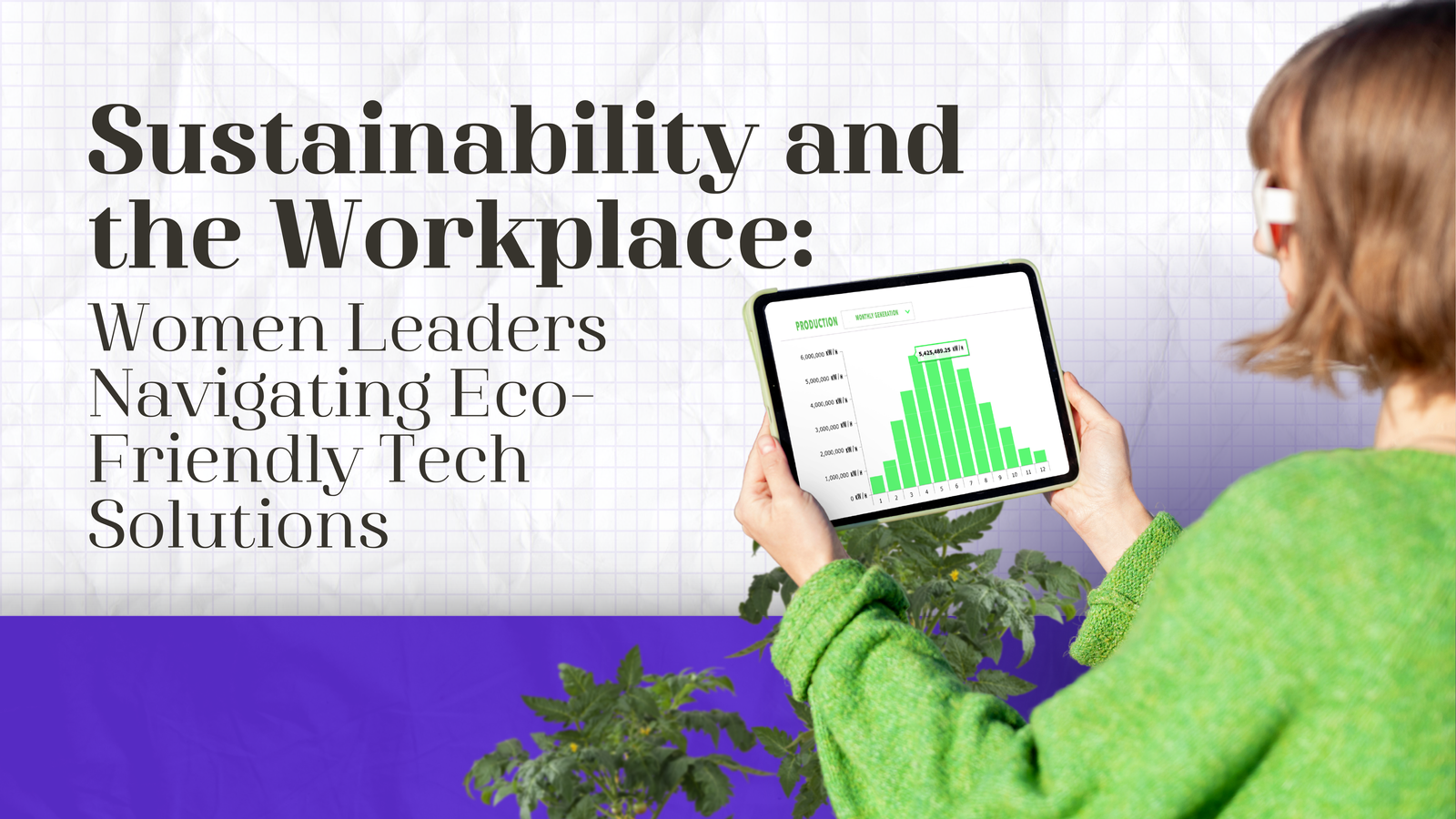Event Schedule | Event Location

As the global climate crisis intensifies, the role of businesses in fostering sustainability has gained significant prominence.
The workplaces in particular, have emerged as a crucial arena for implementing measures that can mitigate environmental impact and contribute to the broader efforts of planetary preservation. And the good thing is that women leaders are already excelling at this!
They have emerged as influential figures, steering their organizations towards eco-friendly practices and contributing significantly to the advancement of sustainability goals in the corporate domain.
Now, what exactly is sustainability in a workplace?
In a nutshell, a sustainable workplace is defined by a steadfast dedication to environmentally responsible business practices, marked by a commitment to reduce ecological footprints, adopt energy-efficient office solutions, and actively pursue waste reduction initiatives.
Here’s a quick stat!
A substantial 83% of millennials express a heightened sense of loyalty towards companies that actively promote greener living and take decisive actions to address environmental concerns.
Now, let’s explore the eco-friendly tech solutions that women leaders implement in their offices for sustainability and examine how they do so:
1. Energy-Efficient Appliances and Lighting
Energy-efficient appliances and lighting represent a cornerstone of sustainable practices in the workplace, and women leaders are at the forefront of implementing these eco-friendly tech solutions.
They prioritize the use of LED (Light Emitting Diode) or CFL (Compact Fluorescent Lamp) lights over traditional incandescent bulbs. LED lights, in particular, consume significantly less energy and have a longer lifespan, reducing the need for frequent replacements.
This not only lowers energy consumption but also decreases the environmental impact associated with the manufacturing and disposal of bulbs.
Other than that, forward-thinking women leaders invest in energy-efficient office appliances, including printers, copiers, and computers.
These appliances are designed to consume less electricity during operation, contributing to reduced energy bills for the organization.
Moreover, by opting for Energy Star-rated equipment, which meets strict energy efficiency guidelines, they ensure that their office technology aligns with industry standards for reduced environmental impact.
Energy-efficient computers, for instance, are designed to operate with advanced power management features, optimizing energy usage based on the system’s activity. This conserves energy and extends the lifespan of computer equipment, reducing electronic waste.
When it comes to printers and copiers, women leaders prioritize models with duplex printing capabilities to minimize paper usage and promote responsible resource management.
2. Smart Thermostats and Sensors
Women leaders make sure to install smart thermostats to optimize the heating, ventilation, and air conditioning (HVAC) systems in their offices.
These intelligent devices leverage advanced algorithms and sensors to assess occupancy levels and usage patterns, adjusting temperature settings accordingly.
The result?
They enhance the comfort of occupants and contribute to significant energy savings.
The ability to program and remotely control these thermostats allows leaders to create tailored schedules based on office hours and occupancy, preventing unnecessary energy consumption during vacant periods.
This targeted approach reduces electricity bills and minimizes the environmental impact associated with excessive energy use.
On top of that, intelligent women leaders integrate motion sensors into their office spaces to control lighting and HVAC systems in areas that are unoccupied.
Motion sensors detect movement and trigger automatic adjustments, ensuring that lights are turned off and climate control settings are optimized when spaces are not in use.
In addition to conserving energy, motion sensors enhance workplace safety and security by illuminating spaces only when necessary.
3. Renewable Energy Sources
Leading the way to a greener future, women leaders are installing solar panels or wind turbines to harness renewable energy for their workplaces.
How?
Solar panels convert sunlight into electricity, and wind turbines capture wind energy to generate power. By utilizing these technologies, leaders reduce reliance on traditional energy sources, mitigating their carbon footprint and promoting cleaner, greener alternatives.
The installation of solar panels, in particular, generates on-site renewable energy and offers the potential for excess power to be fed back into the grid, contributing to broader sustainability efforts in the community.
Moreover, many governments are providing incentives to install such technologies!
Women leaders also actively engage in purchasing renewable energy credits as part of their commitment to sustainable practices.
Renewable energy credits represent certificates that verify the production of a certain amount of renewable energy.
By investing in these credits, leaders support renewable energy projects elsewhere, even if on-site renewable generation is not feasible. This allows them to contribute to the growth of clean energy infrastructure on a broader scale.
4. Remote Work and Virtual Meetings
Amidst the changing dynamics of the modern workplace, women leaders are championing a transformative approach by embracing remote work and virtual meetings.
This paradigm shift not only enhances productivity but also underscores a commitment to environmental sustainability.
By 2025, the work landscape is projected to undergo a significant shift, with approximately 32.6 million Americans expected to work remotely.
Now let’s discuss how and what women leaders do to transform the work environment.
They already recognize the impact of commuting on both employee well-being and the environment.
That’s why they prefer remote work. It significantly reduces the need for daily commutes, thereby cutting down on carbon emissions associated with traditional transportation methods.
This shift towards remote work not only aligns with a better work-life balance but also contributes to a substantial decrease in the organization’s overall carbon footprint.
With fewer employees commuting, there is a tangible reduction in traffic congestion and air pollution.
Additionally, recognizing the importance of face-to-face communication without the need for physical presence, women leaders leverage video conferencing tools to conduct virtual meetings.
Such meetings call for efficient communication and collaboration while eliminating the need for flights or long-distance travel.
5. Green Building Design
Women leaders mostly go for sustainable building materials, opting for those with low environmental impact and high recyclability. This includes materials like reclaimed wood, recycled steel, and environmentally friendly concrete alternatives.
In addition to material choices, leaders promote construction practices that minimize waste and carbon emissions.
Efficient waste management and recycling on construction sites are key strategies, ensuring that the environmental impact of the building process is kept to a minimum.
On the other hand, women leaders focus on implementing energy-efficient insulation to regulate indoor temperatures effectively.
This not only enhances the comfort of the workspace but also reduces the need for excessive heating or cooling, leading to significant energy savings.
Emphasizing the importance of natural light, leaders invest in energy-efficient windows designed to optimize daylight while minimizing heat gain or loss.
6. Waste Reduction and Recycling
The biggest problem in today’s organizational landscape is waste reduction and recycling.
However, women tackle that smartly!
They are championing waste reduction through the strategic setup of recycling stations within office spaces. These stations are designed to collect various recyclable materials, including paper, plastic, glass, and electronics.
The implementation of these recycling stations is often part of a broader waste management strategy, encouraging employees to segregate waste at the source. This approach facilitates recycling and minimizes the amount of waste destined for landfills.
Moreover, they actively promote a paperless office culture. They encourage digital documentation and communication, emphasizing the use of electronic formats for memos, reports, and other forms of correspondence.
7. Water Conservation
In the pursuit of sustainable practices, women leaders are always ahead in implementing water conservation initiatives within their organizations.
They ensure water efficiency by opting for the installation of low-flow faucets and toilets throughout office spaces.
Low-flow fixtures are designed to reduce water consumption by regulating flow rates, ensuring that water is used more efficiently without compromising functionality.
An integral part of water conservation strategies involves encouraging employees to promptly report and address water leaks.
Women leaders foster a culture of responsibility by instilling awareness among employees about the impact of leaks on water wastage and the environment.
Quick reporting and timely repairs of leaks not only prevent water waste but also contribute to the overall sustainability of the workplace.
8. Green Transportation Incentives
Women leaders are taking proactive steps to promote green transportation within their organizations, recognizing the significant impact it can have on both environmental sustainability and employee well-being.
That’s the reason they provide incentives for employees who use public transportation, carpool, bike, or walk to work. These incentives may include subsidies, discounted transit passes, or recognition programs for sustainable commuting practices.
As we all are aware of the growing popularity of electric vehicles (EVs), women leaders are taking the initiative to install electric vehicle charging stations in the workplace.
This not only accommodates employees who drive electric vehicles but also serves as a practical step toward encouraging the adoption of cleaner transportation options.
Moreover, they are also offering on-site charging facilities which eliminates the concern of EV owners about finding charging stations, making it more convenient for employees to choose electric vehicles.
The Bottom Line!
So, that’s the end of it! We discussed 8 eco-friendly tech solutions that women leaders are adopting to ensure sustainability in the workplace.
And let us remind you these are not all! There are many other solutions that women leaders regularly promote to make sure the environment is greener and healthier than ever!



